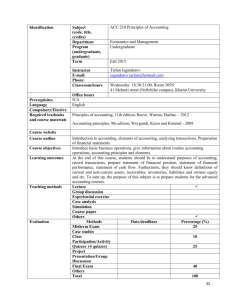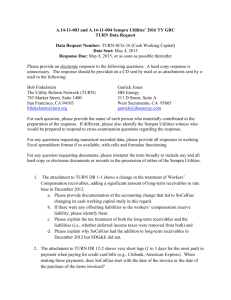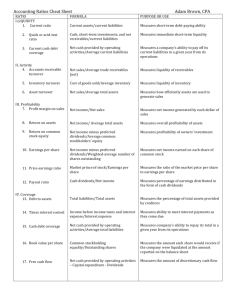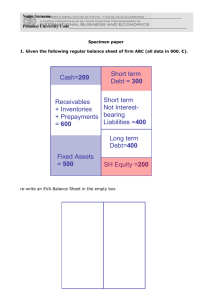RELATIONSHIP BETWEEN THE EFFICIENCY OF WORKING CAPITAL MANAGEMENT AND COMPANY SIZE
advertisement
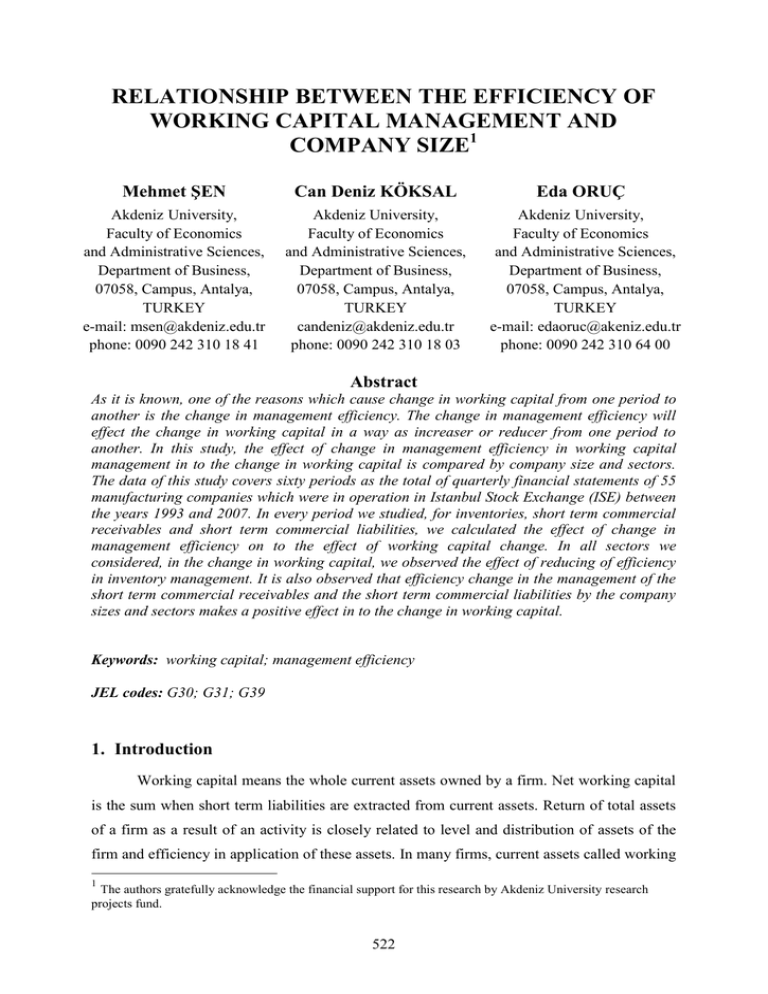
RELATIONSHIP BETWEEN THE EFFICIENCY OF WORKING CAPITAL MANAGEMENT AND COMPANY SIZE1 Mehmet ŞEN Can Deniz KÖKSAL Eda ORUÇ Akdeniz University, Faculty of Economics and Administrative Sciences, Department of Business, 07058, Campus, Antalya, TURKEY e-mail: msen@akdeniz.edu.tr phone: 0090 242 310 18 41 Akdeniz University, Faculty of Economics and Administrative Sciences, Department of Business, 07058, Campus, Antalya, TURKEY candeniz@akdeniz.edu.tr phone: 0090 242 310 18 03 Akdeniz University, Faculty of Economics and Administrative Sciences, Department of Business, 07058, Campus, Antalya, TURKEY e-mail: edaoruc@akeniz.edu.tr phone: 0090 242 310 64 00 Abstract As it is known, one of the reasons which cause change in working capital from one period to another is the change in management efficiency. The change in management efficiency will effect the change in working capital in a way as increaser or reducer from one period to another. In this study, the effect of change in management efficiency in working capital management in to the change in working capital is compared by company size and sectors. The data of this study covers sixty periods as the total of quarterly financial statements of 55 manufacturing companies which were in operation in Istanbul Stock Exchange (ISE) between the years 1993 and 2007. In every period we studied, for inventories, short term commercial receivables and short term commercial liabilities, we calculated the effect of change in management efficiency on to the effect of working capital change. In all sectors we considered, in the change in working capital, we observed the effect of reducing of efficiency in inventory management. It is also observed that efficiency change in the management of the short term commercial receivables and the short term commercial liabilities by the company sizes and sectors makes a positive effect in to the change in working capital. Keywords: working capital; management efficiency JEL codes: G30; G31; G39 1. Introduction Working capital means the whole current assets owned by a firm. Net working capital is the sum when short term liabilities are extracted from current assets. Return of total assets of a firm as a result of an activity is closely related to level and distribution of assets of the firm and efficiency in application of these assets. In many firms, current assets called working 1 The authors gratefully acknowledge the financial support for this research by Akdeniz University research projects fund. 522 capital make up of a remarkable part of total assets. But it is obvious that working capital is neglected in finance literature compared to long term financing decisions. Studies on corporate finance generally focus on main decisions like capital structure, dividend and capital budgeting. However, the amount of assets group a significant part of total asset and called working capital (money and quasi money, trade receivables, inventories and short term liabilities) is a focus matter in all main books relating to corporate finance where efficiency level of distribution and application of assets influence profitability and risk level of the firm. The main objective of a firm is to increase the market value. Working capital management affects profitability of the firm, its risk, thus its value (Smith 1980). In other words, efficient management of working capital is an important component of the general strategy aiming at increasing the market value (Howorth & Westhead, 2003; Deloof, 2003; Afza & Nazir, 2007). Since the flexibility of this group of assets is very high in terms of adapting to changing conditions and due to these characteristics they can often be applied to realize the main objective of financial management through policy changes. The fundamental subject of working capital is to provide optimal balance between each element forming working capital. Most of the efforts of finance directors in a firm are the efforts they make to carry the balance between current assets not at optimal level and responsibilities to an optimal level (Lamberson, 1995). The most important of all, it is the determination of investment volume and to which asset it will be invested (Appuhami, 2008:11). One reason for this is the decisive influence of current assets on others, one another reason is the obligation of fulfillment of current responsibilities. Working capital necessity influences liquidity level and profitability of a firm. As a result, it affects investment and financing decisions, too. Despite the compounds of working capital that a company must have, basically depends on the company type and the sector in which it operates. Company size, growth rate and cash flow are the other important factors. If the determination factors are not explained fully and adequacy of working capital is undetermined, companies would be routed to bankruptcy (Appuhami, 2008:11, Ramachandran, Kanakiraman, 2009:64). Amount of current assets to be calculated at a level where total cost is of a minimum degree means an optimum working capital level. The optimum working capital level is the case in which balance between risk and efficiency is provided. A quest for such balance requires a constant monitoring of the elements forming working capital. 523 2. Efficiency of Working Capital Management In finance literature there is a common opinion about the importance of working capital management. Explanations about why working capital management is significant for a firm generally focus on the relationship between efficiency in working capital management and firm profitability. Efficient working capital management includes planning and controlling of current liabilities and assets in a way it avoids excessive investments in current assets and prevents from working with few currents assets insufficient to fulfill the responsibilities. In relevant studies the measure taken as an indicator of efficiency in working capital management is usually cash conversion cycle. Cash conversion cycle for a firm is the period during which it is transited from money to good and again to money. The more cash conversion cycle of the firm extends, the more financing is allocated to working capital (Deloof, 2003). Extension of cash conversion cycle can increase the sales, thus profits of the firm. But increasing need for working capital in parallel with the extension of cash conversion cycle brings together an additional financing cost. On this matter Kienschnick et al. (2006) emphasized that an additional dollar invested in working capital would be less than a dollar, indeed. In the studies conducted by Shin and Soenen (1998), Deloof (2003), Raheman and Nasr (2007) and Teruel and Solano (2007) it was concluded that there is a negative relationship between profitability of a firm and cash conversion cycle. Thus, it is possible to increase firm profitability through more efficient working capital management. To realize this, it is necessary that main elements of cash conversion cycle (short term trade liabilities, short term account receivables and inventories) should be managed in a way they maximize firm profitability. An efficient working capital management will increase free cash flows to the firm and growth opportunities and returns of stockholders. Working capital level of a firm indicates that it wants to take a risk. The more working capital amounts, the lower liquidity risk and profitability become. Filbeck and Krueger (2005) stated that working capital policies of firms vary according to the sectors and within each sector it changes over time. Ganesan (2007) put forward that the firms in less competitive sectors focus on cash conversion minimizing receivables, while the firms in more competitive sectors have a relatively higher level of receivables. Lazaridis and Tryfonidis (2005) stated that small firms focus on inventory management, the firms with low profitability on credit management. 524 Statements in finance literature about the importance of working capital for firms are being once more emphasized in these turbulent days of global economies. While firms make efforts to increase return on assets in a way they pay their due obligations as late as possible and keep the cash, decreases in activity volume decreases the cash flow, too and this case increases the liquidity risk (Hofler, 2009). Success of a company generally depends on its financial manager’s efficient management ability of receivables, inventories and liabilities (Filbeck & Krueger, 2005). Companies can decrease their resource costs by decreasing amount of resource assigned to circulating assets or they can increase their funding abilities. Compounds of working capital can be change within time. One of the main reasons of this change is the change in management efficiency. When management efficiency goes higher, a decrease is expected in the resources which assigned to working capital. In other words, it is expected that more than enough resource should not be assigned to working capital. In our study, we are going to handle the effect of management efficiency in the change of working capital of the companies which are being traded in Istanbul Stock Exchange (ISE) by taking into account their sizes, sectors and figures from one period to another. In this study we are going to handle the change in management efficiency for commercial inventories, receivables and commercial liabilities. Firstly, method and data used in analyses will be explained and than findings and results will be discussed. 3. Data and Methodology This study aims to find out the relationship between the efficiency levels of working capital management and sizes of companies which are being traded in Istanbul Stock Exchange (ISE). Sales volumes were used as the size indicators. We carried out this study via 3 month- financial table data declared by 55 production firms being traded in ISE continually between 1993 and 2007. Data of 60 periods based on 3 months-financial table for 15 years for the each firm were used. The firms involved in this study are in the sectors named as; textile, food, cement, white goods & electronic, chemistry and metal main industries with the counts as 8, 6, 16, 6, 14, 5, respectively. While management efficiencies are being examined, companies were grouped in two categories as high sales volume and low sales volume ones on the basis of their sales volumes. This grouping has been done for every period along 15 years of data by sectors. Thus, it is examined that groups in which the management efficiencies are found high or low. In order to group companies as large and small sized ones, 525 a ranking process applied according to companies’ sales volumes for each sector in every period. And than, companies with higher sales volumes than their sectoral sales average were assigned to the group of large and the others were assigned to the group of smalls. This grouping process has been done for 60 periods. Abbreviations of terms: ECIM = Efficiency Change in Inventory Management ECRM = Efficiency Change in Receivables Management ECLM = Efficiency Change in Liabilities Management APEI = Adjusted Period-End Inventories APEAR = Adjusted Period-End Amount of Receivables APEACL = Adjusted Period-End Amount of Commercial Liabilities ACS = Adjusted Cost of Sales AANS = Adjusted Amount of Net Sales PPIT = Previous Period Inventory Turnover PPRT = Previous Period Receivables Turnover PPLT = Previous Period Liabilities Turnover Effect of change in management efficiency was calculated with the formulas as below: ECIM = APEI – (ACS / PPIT) (1) ECRM = APEAR – (AANS / PPRT) (2) ECLM = APEACL – (ACS / PPLT) (3) Corrections in these calculations were made using sectoral inflation index due sectors in which companies are being traded. Calculations of correction process for APEI, APEAR, APEACL, ACS and AANS are as below: APEI = (Period-End Inventory) / (1 + Sectoral Inflation Index) APEAR = (Period-End Amount of Receivables) / (1 + Sectoral Inflation Index) APEACL = (Period-End Amount of Commercial Liabilities) / (1 + Sectoral Inflation Index) ACS = (Cost of Sales) / (1 + Sectoral Inflation Index) AANS = (Amount of Net Sales) / (1 + Sectoral Inflation Index) The signs of values which calculated with the above mentioned methods are important. If the sign found negative for inventories and commercial receivables this means that there is an increase in management efficiency and it also means that there is a same amount of decrease 526 in resource allocation. On the contrary, if the sign found positive for the inventories and commercial receivables, this finding is evaluated as there is a decrease in management efficiency, and related with this reason, this finding is evaluated that there is a same amount of increase in resource allocation. Effects of the change in management efficiency for each group in each sector through 60 periods were calculated separately. Thus, we have had the data set from the values of each group for every sector which showed the change in management efficiency, and than, the companies with negative and positive values were classified. After classification process, total values for each group in each sector are given in Table1. According to the results of calculations, negative values were determined as the good indicators for the efficiencies of inventory and receivables management, while positive values were determined as the good indicators for efficiency of liabilities management. These negative and positive values are figured as percentages in Table2. 4. Findings and Results Results, which show the effects of change for inventories, commercial receivables and commercial liabilities are given in Table1 on the basis of sectoral, grouped and signs of values. Results given in Table1 should be commented separately for inventories, commercial receivables and commercial liabilities. As related with the effect of change in management efficiency for inventory, it is seen that, sum of positive results are higher than sum of negative results in each sector for both groups. This result shows us that, for the sectors and periods we handled and regardless of what size of their sales volumes, there are problems in every sector related with management efficiency in inventory management. Because, in every sector and in both groups, sum of negative results as the reason of attributing fewer resource into inventories due to management efficiency is under the sum of positive results as the reason of attributing more resource due to management inefficiency. Together with this, the higher level of relative efficiency ratio on inventory management between groups can be shown in Table2. Values in Table2 were calculated by dividing the sum of results (negative results for short term commercial receivables and inventories. Positive results for short term commercial liabilities.), which indicate an increase in management efficiency, to the sum of results which indicate a decrease in management efficiency. According to the results in Table2, there is a considerable relative superiority of the companies with low sales volumes in textile and cement sector against the companies which with high sales volumes by the mean of efficiency change in inventory management. Companies, with high sales volumes, have got relative 527 superiorities in food and white goods & electronic sectors. But, there are no specific differences between the groups in chemistry and metal main industries. Table 1 Results of Change in Management Efficiency SECTORS Textile Food Cement White Goods & Electronic Chemistry Metal Main Ind. SECTORS Textile Food Cement White Goods & Electronic Chemistry Metal Main Ind. SECTORS Textile Food Cement White Goods & Electronic Chemistry Metal Main Ind. Inventories Low Sales Volumes High Sales Volumes Sum of Sum of Sum of Sum of Negative Results Positive Results Negative Results Positive Results 188,571,231 1,336,753,810 721,198,969 10,234,358,923 196,987,659 3,018,266,943 562,254,374 5,828,104,216 652,857,818 5,827,576,747 1,217,353,423 14,775,257,384 92,806,749 323,595,088 3,479,645,878 10,377,541,994 633,374,241 7,613,296,888 7,127,712,180 79,900,753,196 111,820,447 2,231,442,137 2,699,409,665 45,427,785,343 Commercial Receivables Low Sales Volumes High Sales Volumes Sum of Sum of Sum of Sum of Negative Results Positive Results Negative Results Positive Results 493,393,462 177,828,183 3,869,437,771 1,406,247,748 1,658,294,546 567,194,450 1,344,862,590 396,318,824 1,661,507,881 570,871,706 5,387,044,472 1,635,148,855 158,505,617 67,977,638 11,940,986,872 4,190,787,773 3,616,382,625 1,634,015,179 24,166,139,835 9,093,610,929 838,041,697 310,564,090 6,431,421,847 2,367,358,538 Commercial Liabilities Low Sales Volumes High Sales Volumes Sum of Sum of Sum of Sum of Negative Results Positive Results Negative Results Positive Results 262,395,285 619,822,210 2,466,512,679 6,602,056,568 1,788,438,379 2,351,686,167 1,916,882,622 4,852,928,444 1,035,323,597 2,911,698,010 3,967,869,724 6,467,914,331 173,664,087 224,880,647 13,053,133,652 16,347,672,041 2,178,523,416 8,615,576,081 28,933,037,445 78,403,063,468 482,897,262 1,155,554,159 5,897,631,136 18,988,666,589 Source:Authors’ calculation For receivables, related with the change in management efficiency, sum of resource assignment fewer than necessary due to efficiency in management is more than the sum of allocation reasoned by management inefficiency. This result shows the increase of efficiency on receivable management for both business groups in each sector. On the other hand, relatively good efficiency ratios for per inefficiencies can be seen in Table2 for each sector in each group. According to the results in Table2, it can be said that companies with higher sales volumes in cement, white goods & electronic, chemistry and metal main sectors are managed their receivables relatively more efficient than the companies with low sales volumes. But, the results are vice versa in textile sector. 528 Table 2 Ratios of Change in Management Efficiency by Groups and Sectors SECTORS Textile Food Cement White Goods & Electronic Chemistry Metal Main Industries Inventories Low High Sales Sales Volumes Volumes 0.14 0.07 0.07 0.10 0.11 0.08 0.29 0.34 0.08 0.09 0.05 0.06 Commercial Receivables Low High Sales Sales Volumes Volumes 2.77 2.75 2.92 3.39 2.91 3.29 2.33 2.85 2.21 2.66 2.70 2.72 Commercial Liabilities Low High Sales Sales Volumes Volumes 2.36 2.68 1.31 2.53 2.81 1.63 1.29 1.25 3.95 2.71 2.39 3.22 Source: Authors’ calculation Related with the effect of change in management efficiency for short term commercial liabilities, the sum of positive results which indicates the increase in management efficiency are higher than the sum of negative results which indicates decrease in management efficiency. And this situation shows us that companies have efficient management on the issue of managing the short term commercial liabilities. Levels of these relative efficiencies can be seen with theirs groups in Table2. It can also be concluded from Table2, that, companies with higher sales volumes in textile food and metal main sectors are shown relatively efficient, but on the contrary, the companies with lower sales volumes in cement, white goods & electronic and chemistry sectors are shown relatively efficient. 5. Conclusion Financial needs of companies will be decreased with the efficiency gained from the management of elements of working capital, and it will be succeeded to do the same volume of work with the assignment of less resource. In this study, management inefficiency in the issue of inventory management related with ISE companies is seen as a major result. Although there is a considerable efficiency in the management of short term commercial receivables and short term commercial liabilities related with company sizes and sectors, efficiency decrease in inventory management has a great importance than all. In terms in which resource finding has a lot of difficulties, bank managements prefer to give credit for receivables rather than giving credit for inventories. Because, receivables are more liquid than inventories and it is quite easy to convert them into cash, too. Companies in Istanbul Stock Exchange should give more attention to inventory management in the issue of working capital management. Regulations on this matter which increase management efficiency will be beneficial for the companies and for the rest of economic structure. 529 References [1] AFZA, T., NAZIR, M. S. Is it better to be Aggressive or Conservative in Managing Working Capital?. Presented at Singapore Economic Review Conference (SERC). 2007, p. 1-15. [2] APPUHAMI, B. A. R. The Impact of Firms’ Capital Expenditure on Working Capital Management: An Empirical Study across Industries in Thailand. International Management Review. 2008, vol. 4, No.1, p. 8-21. [3] DELOOF, M. Does working capital management affect profitability of Belgian firms?. Journal of Business Finance & Accounting. 2003, vol. 30, no. 3&4, p. 573-588. [4] FILBECK, G., Krueger, M. T. An Analysis of Working Capital Management Results Across Industries. Mid-American Journal of Business. 2005, vol. 20, No. 2, p. 11-18. [5] GANESAN, V. An Analysis of Working Capital Management Efficiency in Telecommunication Equipment Industry. Rivier Academic Journal. 2007, vol. 3, No. 2, p. 1-10. [6] HOFLER, D. Strategies for High-yield working capital in Today’s economic environment. 2009, p. 27-29. Access from: <http://outsourcedlogistics.com/field_reports/strategies_highyield_working_capital_1208 > [7] HOWORTH, C., WESTHEAD, P. The focus of working capital management in UK small firms. Management Accounting Research. 2003, vol. 14, p. 94-111. [8] KIENSCHNICK, R., LAPLANTE, M., MOUSSAWI, R. Corporate working capital management: determinants and consequences. 2006. Access from: <http://www.fma.org/SLC/Papers/cwcmf_fma.pdf> [9] LAMBERSON, M. Changes in Working Capital of Small Firms in Relation to Changes in Economic Activity. Mid-American Journal of Business. 1995, vol. 10, no. 2, p. 45-50. [10] LAZARIDIS, D. I., TRYFONIDIS, D. The relationship between working capital management and profitability of listed companies in the Athens Stock Exchange. Journal of Financial Management and Analysis. 2005, vol. 19, no. 1, p. 1-12. [11] RAHEMAN, A., NASR, M. Working Capital Management and Profitability: Case of Pakistani Firms, International Review of Business Research Papers. 2007, vol. 3, p. 279300. 530 [12] RAMACHANDRAN, A., JANAKIRAMAN, M. The Relationship Between Working Capital Management Efficiency and EBIT. Managing Global Transitions. 2009, Vol. 7, No. 1, Spring, p. 61-74. [13] SHIN, H. H., SOENEN, L. Efficiency of working capital management and corporate profitability. Financial Practice and Education. 1998, vol. 8, no. 2, p. 37-45. [14] SMITH, K. Profitability versus Liquidity Tradeoffs in working capital management. Readings on the Management of Working Capital. 1980, p. 549-62. [15] TERUEL, P. J. G., SOLANO, P. M. Effects of working capital management on SME profitability. International Journal of Managerial Finance. 2007, vol. 3, no. 2, p. 164177. 531
